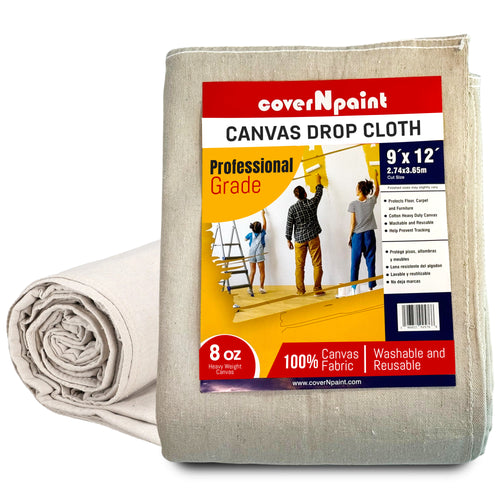Whether you are a professional painter or a DIY enthusiast, one of the most essential tools for protecting your surfaces is a painters drop cloth. From canvas drop cloths to standard paint drop cloths, these durable covers prevent floors, furniture, and other surfaces from paint spills, drips, and splatters. Proper care and handling of your drop cloths ensure they last longer, perform better, and contribute to a more efficient painting process.

Why Maintaining Your Painters Drop Cloth Matters
Many painters underestimate the importance of maintaining their drop cloths. Neglecting proper care can lead to:
-
Reduced lifespan: Paint stains, dirt, and moisture can degrade the fibers of your cloth.
-
Safety hazards: Wet or dirty drop cloths can be slippery, increasing the risk of accidents.
-
Compromised results: Residual paint on a dirty drop cloth can transfer to your surfaces during future projects.
Proper maintenance not only saves money but also ensures a safer, cleaner, and more professional painting experience. For additional insights on using sustainable painting tools effectively, check out our guide on Eco-Friendly Advantages of Using a Canvas Painters Drop Cloth in 2025.
Step 1: Cleaning Your Painters Drop Cloth
Determine The Material
The first step in cleaning your drop cloth is identifying the material. Most drop cloths fall into three categories:
-
Canvas drop cloths: Durable and reusable, ideal for multiple projects.
-
Plastic or polyethylene drop cloths: Lightweight and usually disposable, but can be cleaned for reuse.
Remove Excess Paint
-
Shake the drop cloth outside to remove loose paint particles.
-
Use a plastic scraper for stubborn, dried paint, ensuring the fabric is not damaged.
Pre-Treat Stains
-
Apply a mild laundry detergent or dish soap to paint spots.
-
Let it sit for 10–15 minutes before washing to effectively lift the paint.
Washing Guidelines
-
Canvas drop cloths: Machine wash on a gentle cycle with cold water. Avoid bleach to preserve the fibers.
-
Plastic or polyethylene drop cloths: Wipe clean with warm water and mild soap. Machine washing is not recommended.
Drying Tips
-
Hang canvas drop cloths outdoors in a shaded area. Avoid prolonged exposure to direct sunlight as it may weaken the fabric.
-
Ensure plastic drop cloths are completely dry before storing to prevent mold or mildew.
Step 2: Proper Storage Of Drop Cloths
Fold Or Roll Carefully
-
Fold canvas drop cloths along natural creases or roll them loosely to avoid permanent wrinkles.
-
Tight folds may weaken fibers over time, so always maintain some slack.
Store In A Suitable Location
-
Keep your drop cloths in a dry, cool environment. Avoid damp areas to prevent mold and mildew.
-
Breathable storage bags or bins are ideal for keeping dust and dirt off your clothes while allowing airflow.
Organize By Type And Size
-
Separate drop cloths by material or size for easy selection during your next project.
-
Labeling your storage areas can save time and reduce frustration when preparing for a new painting task.
Step 3: Reusing Painters Drop Cloths
Inspect Before Use
-
Examine your drop cloth for holes, tears, or fraying.
-
Small damages can often be patched with tape or sewn to extend the cloth’s life.
Rotate For Even Wear
-
Use larger drop cloths for high-traffic areas and smaller ones for furniture or detailed work.
-
Rotating your drop cloths ensures even wear and longevity.
Layer For Extra Protection
-
For messy tasks such as furniture staining or ceiling painting, consider layering a canvas drop cloth with a lightweight plastic liner to prevent stains from reaching the surface below.
Expert Tips For Long-Term Care
-
Clean Immediately After Use: Removing paint promptly prevents permanent stains and fiber damage.
-
Prevent Slippage: Secure drop cloths on smooth surfaces with painter’s tape for safety.
-
Eco-Friendly Approach: Reusing drop cloths reduces waste and supports environmentally conscious painting practices.
-
Pair With Protective Gear: Using gloves and a tool apron can reduce accidental spills on your drop cloths.
A Curiosity-Building Note
Many painters overlook simple techniques that can dramatically extend the life of a canvas drop cloth. Even small adjustments in folding, cleaning, or layering can save significant money and make your painting experience far more efficient. CovernPaint has shared these expert tips with painters and DIY enthusiasts, helping them get the most out of their drop cloths. Mastering these techniques often surprises both professionals and DIY enthusiasts.

Benefits Of Proper Cleaning And Storage
-
Cost Efficiency: Clean and well-stored drop cloths last longer, reducing frequent replacements.
-
Professional Finish: Residue-free cloths prevent unwanted paint transfer, ensuring pristine results.
-
Safety: Dry, undamaged clothes reduce slips and accidents.
-
Eco-Friendly: Reusable drop cloths support sustainable painting practices.
FAQs
Q1: Can canvas painters drop clothes that are machine washed?
Yes, use a gentle cycle with cold water and mild detergent. Avoid bleach and high heat to protect the fabric.
Q2: How long will a well-maintained drop cloth last?
A high-quality canvas drop cloth can last several years if properly cleaned, stored, and rotated.
Q3: Should paint thinner be used to clean drop cloths?
No. Mild detergent and water are safer and effective. Solvents can damage canvas fibers and reduce lifespan.
Q4: How should drop cloths be stored between painting projects?
Fold or roll loosely, store in a dry and cool area, and use breathable bags to prevent dust and moisture buildup.
Q5: Can plastic drop cloths be reused?
Yes, lightweight plastic drop cloths can be wiped clean and reused for multiple projects if handled carefully.













